What Animal Is Tearing Up My Lawn?
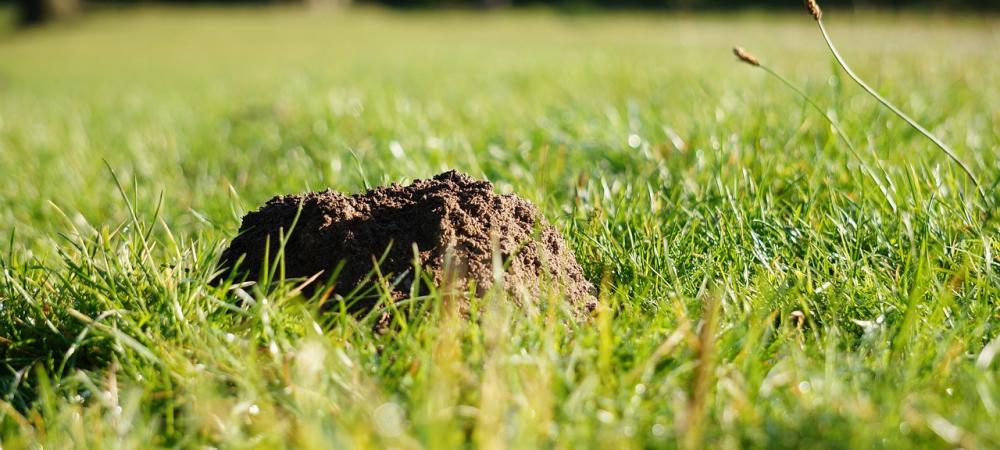
If you’ve noticed mounds of dirt, holes, tunnels, chewed-up plants, or scattered debris in your yard, you might be dealing with unwelcome nocturnal or burrowing guests. In Pittsburgh, common culprits behind torn-up lawns include moles, voles, ground squirrels, groundhogs, skunks, and raccoons. Each pest leaves behind distinct signs of damage, and understanding what you're dealing with can help you take the right action. You can also learn about the best lawn care practices to keep these pests out of your lawn.
Moles
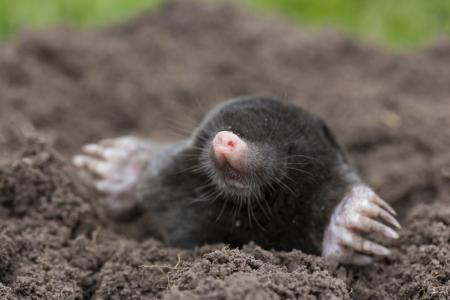
Moles are small, burrowing mammals with velvety, dark gray to brown fur, tiny, nearly invisible eyes, and no external ears. They have elongated, pointed snouts and oversized, paddle-like front feet equipped with strong claws, perfectly adapted for digging through soil. Their cylindrical bodies measure between 4 to 7 inches long, making them compact but powerful diggers.
Signs of Mole Damage
- Raised ridges or tunnels just beneath the soil’s surface, creating a haphazard network across the lawn
- Molehills (small, volcano-shaped dirt mounds) that serve as exit points
- Soft or spongy ground due to extensive tunneling, which can lead to uneven lawns
Why Do I Have Moles In My Yard?
Moles tunnel through yards in search of food, primarily earthworms, grubs, and other soil-dwelling insects. If your lawn has healthy, moist soil rich in organic matter, it is an attractive feeding ground for moles. Their burrowing aerates the soil but can destroy grassroots and ruin landscaping.
How to Keep Moles Out of Your Yard
- Reduce their food source by treating your lawn for grubs.
- Install underground barriers like wire mesh or gravel along garden beds.
- Use castor oil-based repellents, which make the soil unappealing.
- Trap active tunnels with mole-specific traps.
Learn more in our homeowner’s guide to moles.
Voles
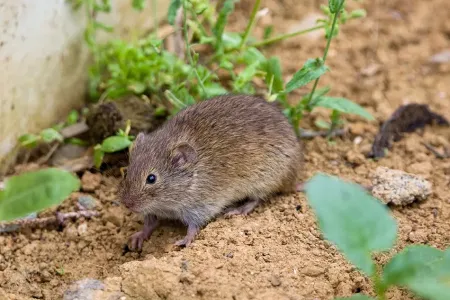
Voles, also known as meadow mice, are small, furry rodents that resemble plump mice but with shorter tails, rounded bodies, and small, rounded ears that are often hidden within their fur. Their fur is typically brown, gray, or black, and they range from 5 to 7 inches in length. Unlike moles, voles are not skilled diggers but instead use existing burrows and tunnels to navigate their habitat.
Signs of Vole Damage
- Surface runways (shallow, worn-down paths in the grass) often seen after snow melts in early spring
- Small burrow holes around garden beds, tree bases, or near concrete slabs
- Gnawed stems, roots, and bark, particularly on shrubs, young trees, and ornamental plants, sometimes girdling and killing the plants
- Sudden die-off of patches of grass due to their feeding on the root system
Why Do I Have Voles In My Yard?
Voles primarily feed on grass, roots, plant bulbs, and seeds, making lush yards, gardens, and flower beds an ideal food source. Heavy mulch, tall grass, and overgrown vegetation provide the perfect cover, allowing voles to thrive and reproduce rapidly, leading to widespread damage if left unchecked.
How to Keep Voles Out of Your Yard
- Keep grass cut short and remove dense mulch to reduce hiding spots.
- Use vole repellents containing castor oil or predator scents.
- Set mouse traps along runways if the population is high.
- Install hardware cloth around tree bases and garden beds.
Ground Squirrels
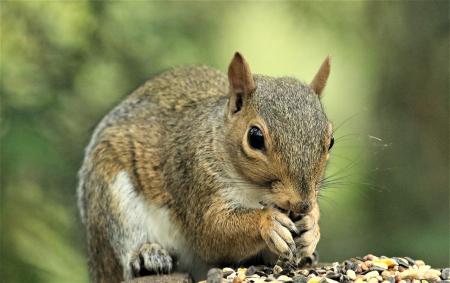
Visual Description: Ground squirrels are larger than voles and moles, measuring between 9 to 12 inches in length, not including their slightly bushy tails. They have a slender body, light brown to tan fur with speckled or mottled patterns, and prominent dark eyes. Unlike tree squirrels, they are more often seen scurrying along the ground rather than climbing trees.
Signs of Ground Squirrel Damage
- Small, round burrow holes (typically 2 to 4 inches in diameter) found near driveways, patios, fences, or open grassy areas
- Uneven patches of grass or dirt caused by their burrowing activity
- Damage to garden plants, vegetables, and flowers due to feeding
- Evidence of stored food, such as seeds or nuts buried around their burrows
Why Do I Have Ground Squirrels In My Yard?
Ground squirrels dig burrows to create nesting sites and shelter. They often feed on plant material, seeds, nuts, and insects, making gardens and lawns ideal habitats. Loose, well-draining soil allows them to create extensive underground networks, which can lead to soil instability and even structural damage if burrows extend under sidewalks or foundations.
How to Keep Ground Squirrels Out of Your Yard
- Fill in burrow entrances with gravel to make re-digging difficult.
- Apply natural repellents like cayenne pepper or predator urine.
- Use live traps and relocate them at least 5 miles away (check local regulations).
- Encourage natural predators like hawks and owls.
Groundhogs
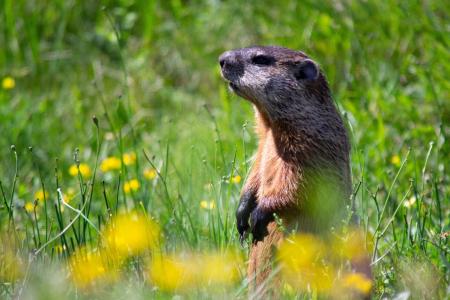
Groundhogs, also known as woodchucks, are large, stocky rodents covered in coarse brownish-gray fur. They have short legs, small rounded ears, and sharp claws suited for digging. Groundhogs can grow between 16 to 27 inches long and weigh up to 14 pounds.
Signs of Groundhog Damage
- Large burrow entrances (10-12 inches wide) near sheds, decks, or garden beds
- Mounds of displaced soil around burrow entrances
- Extensive plant damage, especially missing vegetables, flowers, and gnawed stems
- Weakened structures if burrows extend under foundations or patios
Why Do I Have Groundhogs In My Yard?
Groundhogs dig burrows for shelter and hibernation. They are herbivores that love munching on gardens, grass, and ornamental plants. If your lawn provides plenty of vegetation and soft soil, it becomes an ideal home for these large burrowers.
How to Keep Groundhogs Out of Your Yard
- Install heavy-duty fencing at least 12 inches underground to block tunnels.
- Remove attractants like fallen fruit and overgrown vegetation.
- Use ammonia-soaked rags or Epsom salts near burrow entrances to drive them away.
- Live trap and relocate them (per Pennsylvania wildlife laws).
Skunks
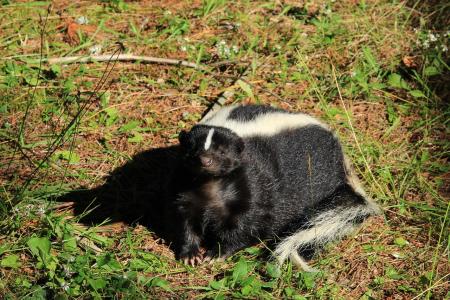
Skunks are small, furry mammals with distinctive black-and-white striped coats. They have bushy tails, small heads, and short legs. Adults typically grow between 15 to 20 inches long, with tails adding another 7 to 15 inches to their length.
Signs of Skunk Damage
- Small, shallow holes in the lawn where skunks dig for grubs and insects
- Overturned soil and scattered debris around gardens and flower beds
- A strong, pungent odor lingering around your property
- Signs of rummaging through trash cans or pet food left outdoors
Why Do I Have Skunks In My Yard?
Skunks primarily feed on insects, grubs, and small rodents, which can be abundant in well-maintained lawns. They are also attracted to easily accessible food sources like compost, pet food, and unsecured garbage bins. They often dig up yards while foraging for food at night.
How to Keep Skunks Out of Your Yard
- Treat your lawn for grubs to remove their food source.
- Secure trash cans and pet food to avoid attracting them.
- Use motion-activated lights or sprinklers to scare them off.
- Seal crawl spaces and sheds to prevent denning.
Raccoons
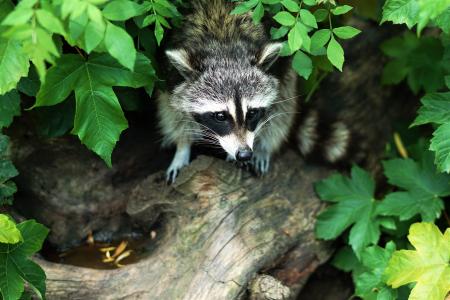
Raccoons are medium-sized mammals with grayish fur, bushy tails, and a characteristic black “mask” around their eyes. They have dexterous front paws that allow them to manipulate objects, open trash bins, and dig up lawns with ease. Adults typically weigh between 10 to 30 pounds and measure around 2 to 3 feet in length.
Signs of Raccoon Damage
- Patches of torn-up grass or rolled sod due to foraging for grubs
- Tipped-over trash cans and rummaged-through garbage
- Claw marks or damage to wooden structures, decks, and fences
- Droppings left behind in concentrated areas, often near feeding sites
Why Do I Have Raccoons In My Yard?
Raccoons are opportunistic feeders drawn to food scraps, compost, pet food, and insects living beneath the turf. Lawns with grub infestations often become prime hunting grounds, as raccoons use their sharp claws to rip up sod in search of larvae.
How to Keep Raccoons Out of Your Yard
- Use a grub control treatment to make your lawn less appealing.
- Secure trash bins with tight-fitting lids or bungee cords.
- Install fencing around vegetable gardens.
- Motion lights and deterrents like ammonia-soaked rags can help keep them away.
How Proper Lawn Care Can Prevent Lawn-Destroying Pests
One of the best ways to keep moles, voles, skunks, raccoons, and other burrowing pests away from your yard is by maintaining a healthy lawn. Many of these animals are drawn to your yard because of food sources like grubs or overgrown vegetation that provide shelter. By keeping your lawn well-maintained and pest-free, you can make your yard far less inviting to unwanted visitors.
Grub Control: The Key to Deterring Lawn Pests
Moles, skunks, and raccoons love to dig up lawns in search of grubs—small beetle larvae that live in the soil and feed on grass roots. If your yard has a grub infestation, you’re practically rolling out a buffet for these pests.
- Apply a grub control treatment in early summer or early fall when larvae are most vulnerable.
- Use nematodes or milky spore to naturally reduce grub populations.
- Water deeply but infrequently to avoid creating the moist soil conditions that grubs love.
Proper Lawn Maintenance to Prevent Pests
A well-maintained lawn is less likely to attract burrowing critters. Here’s what you can do:
- Mow Regularly: Tall grass provides cover for voles and other small rodents. Keep your lawn at an optimal height of 2.5 to 3 inches.
- Aerate & Dethatch: A thick thatch layer can provide a nesting spot for voles and insects. Aerate your lawn in the spring or fall to improve soil health.
- Remove Debris & Overgrown Areas: Tall weeds, brush piles, and clutter create ideal hiding spots for ground squirrels, voles, and groundhogs.
- Install Barriers: Use hardware cloth or underground fencing around garden beds and structures to deter burrowing animals.
Partnering with Custom Turf for Lawn Pest Prevention
If you want a pest-resistant lawn without the hassle, partnering with a professional lawn care company like Custom Turf can help. Our local lawn experts specialize in:
- Seasonal grub control treatments to keep your lawn free of pests.
- Fertilization & weed control to maintain thick, healthy grass.
- Aeration & overseeding to reduce thatch buildup and strengthen your lawn’s root system.
- Professional mole control treatments to safely and effectively eliminate moles without harming your lawn.
By investing in professional lawn care, you can create a healthier, more beautiful lawn while making it less attractive to destructive wildlife. Contact us today to learn how they can help protect your yard from pests!
